Adisura atkinsoni, the field-bean pod borer, is a moth of the family Noctuidae. The species was first described by Frederic Moore in 1881. It is found in Lesotho, KwaZulu-Natal, Transvaal, Zimbabwe, Mozambique, Zambia, Malawi, Congo, Kenya, Uganda and on Madagascar. It is also present in India, China, Korea, Indonesia (Sumatra), Japan, Sri Lanka, Taiwan, Vietnam and the Himalayan region.

Chilo suppressalis, the Asiatic rice borer or striped rice stemborer, is a moth of the family Crambidae. It is a widespread species, known from Iran, India, Sri Lanka, China, eastern Asia, Japan, Taiwan, Malaysia to the Pacific.
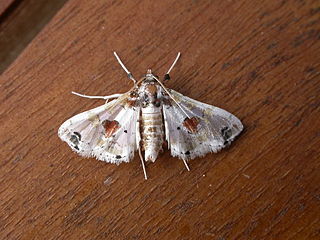
Leucinodes orbonalis, the eggplant fruit and shoot borer or brinjal fruit and shoot borer, is a moth species in the genus Leucinodes described by Achille Guenée in 1854. Its native distribution is in the tropical and subtropical parts of Australia and Asia, where it is recorded from Pakistan, Nepal, India, including the Andaman Islands, Sri Lanka, Bangladesh, Myanmar, Laos, Cambodia, Vietnam, Thailand, China, Taiwan, Japan, Malaysia, Singapore, Brunei, the Philippines, and Indonesia (Java). It has also been intercepted from fruit imports in the U.S.A., the Netherlands, Denmark and Great Britain, where it was also reported from the wild. A taxonomic revision of the Leucinodes species of Sub-Saharan Africa concluded that L. orbonalis is currently not present in Africa, and that previous records of this species were misidentifications of previously undescribed species.

Maliarpha separatella, the African white stemborer, is a species of moth of the family Pyralidae. A worldwide paddy pest, it is found throughout African countries of Cameroon, Mali, Réunion, Madagascar, South Africa, and many Asian paddy cultivating countries such as Myanmar, India, and Sri Lanka. Though they are reported from China and Papua New Guinea, they are also known to attack sugarcane.
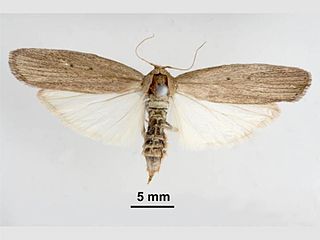
Eldana is a genus of moths of the family Pyralidae containing only one species, the African sugar-cane borer, which is commonly found in Equatorial Guinea, Ghana, Mozambique, Sierra Leone and South Africa. Adults have pale brown forewings with two small spots in the centre and light brown hindwings, and they have a wingspan of 35mm. This species is particularly relevant to humans because the larvae are a pest of the Saccharum species as well as several grain crops such as sorghum and maize. Other recorded host plants are cassava, rice and Cyperus species. When attacking these crops, E. saccharina bores into the stems of their host plant, causing severe damage to the crop. This behavior is the origin of the E. saccharrina's common name, the African sugar-cane borer. The African sugar-cane borer is a resilient pest, as it can survive crop burnings. Other methods such as intercropping and parasitic wasps have been employed to prevent further damage to crops.
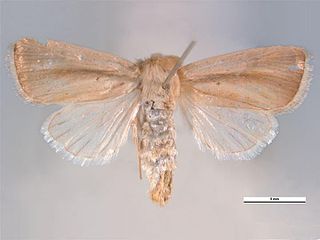
Sesamia inferens, the Asiatic pink stem borer, gramineous stem borer, pink borer, pink rice borer, pink rice stem borer, pink stem borer, purple borer, purple stem borer or purplish stem borer, is a moth of the family Noctuidae. The species was first described by Francis Walker in 1856. It is found from Pakistan, India, Sri Lanka, Myanmar to Japan and the Solomon Islands. A polyphagous species, it is a major pest in many crops worldwide.
Ancylolomia chrysographellus, the angled grass moth, is a species of moth in the family Crambidae. It is found on Cyprus and in Kenya, Uganda, Yemen, India, Pakistan, Sri Lanka, Myanmar, China, Korea, Japan, Taiwan, the Philippines and Indonesia.

Parapoynx stagnalis, the rice case bearer or rice caseworm, is a species of moth in the family Crambidae. It has a wide distribution and is found in India, Sri Lanka, South-East Asia, South Africa, South America, southern Europe, Russia and Australia.

Ostrinia furnacalis is a species of moth in the family Crambidae, the grass moths. It was described by Achille Guenée in 1854 and is known by the common name Asian corn borer since this species is found in Asia and feeds mainly on corn crop. The moth is found from China to Australia, including in Java, Sulawesi, the Philippines, Borneo, New Guinea, the Solomon Islands, and Micronesia. The Asian corn borer is part of the species complex, Ostrinia, in which members are difficult to distinguish based on appearance. Other Ostrinia such as O. orientalis, O. scapulalis, O. zealis, and O. zaguliaevi can occur with O. furnacalis, and the taxa can be hard to tell apart.
Indarbela quadrinotata, the bark-eating caterpillar, is a moth in the family Cossidae. It is found in India and Sri Lanka. It was described by Francis Walker in 1856.
Chilo infuscatellus, the yellow top borer or sugarcane shoot borer, is a moth in the family Crambidae. It was described by the Dutch entomologist Samuel Constantinus Snellen van Vollenhoven in 1890. It is found in India, Myanmar, Tajikistan, Afghanistan, Korea, Taiwan, Malaysia, the Philippines and on Java and Timor.
Scirpophaga excerptalis, the white top borer or sugarcane top borer, is a moth in the family Crambidae. It was described by Francis Walker in 1863. It is found in southern Asia from the Indian Subcontinent in the west to southern China in the east, south to New Guinea, possibly Australia and the Solomon Islands.
Scirpophaga nivella is a moth in the family Crambidae. It was described by Johan Christian Fabricius in 1794. It is found in southern Asia from the Indian Subcontinent in the west to southern China in the east, south to New Guinea and Australia, including New Caledonia and Fiji. Some sources have affixed the common name "sugarcane top borer" to it, despite it not being found in sugarcane, because they are confused with the species Scirpophaga excerptalis, which is an actual borer in the tops of sugarcane. Another newer common name that has been invented for these moths is "white rice borer".
Scirpophaga xanthogastrella is a moth in the family Crambidae. It was described by Francis Walker in 1863. It is found in Taiwan, India, Nepal, Sri Lanka and the Philippines.
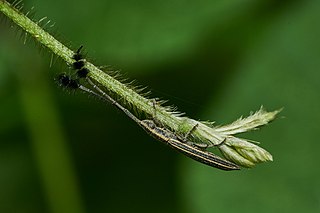
A stemborer is any insect larva, or arthropod, that bores into plant stems. However the term most frequently refers among the Coleoptera to the larva of certain longhorn beetles such as Dorysthenes buqueti and those of the genus Oberea, and among the Lepidoptera to certain moths of the Crambidae, Castniidae, Gelechiidae, Nolidae, and Pyralidae families.
Sturmiopsis inferens is a species of fly in the family Tachinidae. It is native to Asia and is a parasitoid of various moth species whose larvae feed inside the stems of sugarcane, rice and other large grasses, including the Gurdaspur borer and the sugarcane shoot borer.
Trichogramma japonicum is a minute wasp parasitoid from the Trichogrammatidae family in the order Hymenoptera. T. japonicum parasitizes the eggs of many pest species, especially Lepidoptera found in many monocultures. They are entomophagous parasitoids that deposit their eggs inside the host species' egg, consuming the host egg material and emerging from the egg once development is complete. T. japonicum can be found naturally in rice ecosystems, but are dispersed commercially to many monocultures as a biological control. The mitochondrial genomes of T. japonicum are significantly rearranged when comparing it to related insects.
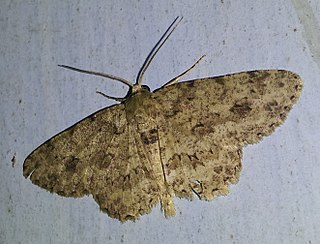
Ectropis bhurmitra, the tea twig caterpillar, is a moth of the family Geometridae. The species was first described by Francis Walker in 1860. A widespread Asian species, it is found around Indo-Australian tropics from India, Sri Lanka and Hong Kong, Taiwan, Thailand, New Guinea to Australian Queensland and the Solomon Islands.
Saluria inficita, the white stem borer, is a moth of the family Pyralidae. The species was first described by Francis Walker in 1863. It is found in India and Sri Lanka.
Naranga diffusa, the rice green semilooper, is a moth of the family Noctuidae. The species was first described by Francis Walker in 1865. It is found in many agricultural based countries such as Bangladesh, India, Sri Lanka, China, Hong Kong, Iran, Japan, the Korean Peninsula, Malaysia, Myanmar, the Philippines, Thailand, Taiwan and Vietnam.











